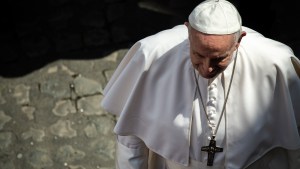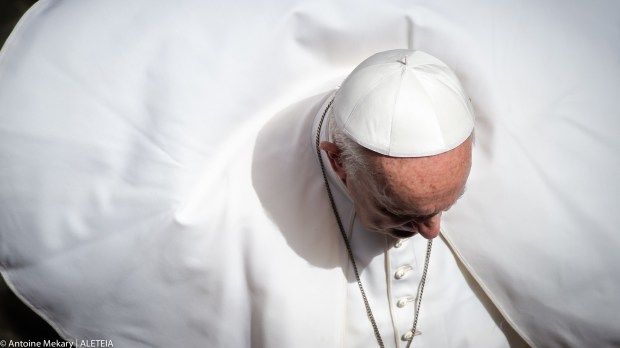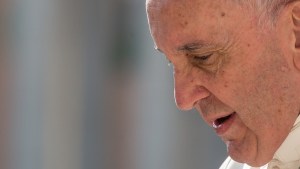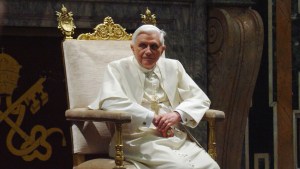The ninth year of Francis’ pontificate might have seemed one of the most difficult since his election to the Throne of Peter on March 13, 2013. I.MEDIA looks back in six points at the great “trials” the Pontiff has had to face this past year.
1The Pope’s health
Never has Francis’ health been so much in the news as it was during this ninth year of his pontificate. In the midst of the Covid-19 pandemic, the head of the Catholic Church, who turned 85 last December, has shown signs of fatigue and underwent a very serious operation.
During the summer, he was hospitalized for 10 days for a colon surgery during which 33 centimeters of intestine were removed.
Naturally, this first hospitalization of the pontificate generated a lot of rumors and speculation about a possible resignation. “Whenever a pope is ill, there is always a breeze – or a hurricane – of conclave,” Pope Francis said in an interview at the end of August. His trip to Budapest and Slovakia in September, followed by a trip to Cyprus and Greece in December, helped to calm things down.
But in recent weeks, it was another health concern that led the Pontiff to cancel some important appointments, including a trip to Florence. The twelfth-oldest pope in history is suffering from knee pain and admitted that it hurts to stand. His next trip to Malta in early April and to the Democratic Republic of Congo and South Sudan in July will be important indicators of his health.
2turbulence in the curia
The ninth year of Pope Francis’ pontificate could have been the year of the publication of the Apostolic Constitution that was supposed to reorganize the Curia. It is still being reviewed, and some resistance and difficulties have emerged in the new structures established in recent years by Francis.
In the “mega-dicastery” he created, dedicated to the service of integral human development, the end of the year proved to be complicated. Cardinal Turkson was replaced by Cardinal Czerny as interim prefect, a change of leadership that was presented as harmless by the Holy See, but which was presented in the press as indicative of something deeper.
Another essential entity of the Curia’s apparatus has also been shaken in recent months: the Dicastery for Communication, which has more than 500 employees. During a memorable visit to its premises, the Pope openly questioned the effectiveness of the Vatican’s media, causing a strong stir among the staff and questions about the reform process begun in 2015.
3Judicial turmoil and financial difficulties
The year was also marked by the London building trial, which opened in July. Ten people – including a cardinal very close to the Pontiff, Angelo Becciu – are on trial in the various aspects of the biggest financial scandal of Francis’ pontificate.
The trial, during its first six months, has proven to be a harsh test of the reforms undertaken by the Pontiff to modernize the Vatican justice system. The competence and legitimacy of the judiciary were questioned on numerous occasions during the first hearings. If this stumbling block seems to have been overcome, the capacity of the small Vatican judicial structure put in place by Francis remains to be demonstrated.
In this trial, it is also the moral credibility of the Catholic Church that seems to be at stake. The great difference between the Franciscan exhortations of the Pope against globalized finance and the mafia-like excesses observed closer to the Throne of Peter seems hardly tenable. And this is all the more true given that the Holy See is going through a difficult economic period.
Last January, the Holy See presented a budget for 2022 in deficit and continues to tighten the screws on spending. The decline in donations and revenues due to the pandemic – including the closing of the Vatican Museums during lockdown – is a thorn in the side of Francis, who still wants to steer the Holy See toward greater charitable and missionary effectiveness.
4Fratelli tutti in the test of war
A year after Pope Francis’ historic visit to Iraq, which seemed to bear the fruits of the encyclical Fratelli tutti, showing the strength of interreligious dialogue in a country traumatized by divisions, it was in Europe that the Pontiff found himself confronted with a war of unexpected proportions. Since the end of February, the Russian offensive in Ukraine has shaken up world geopolitics, but it has also hampered Pope Francis’ efforts at ecumenical outreach to Russian Orthodoxy.
In all his speeches, the Pope has nevertheless avoided frontal criticism of Russia, in order to keep potential channels of diplomatic contact open. His surprise visit to the Russian embassy on February 25 remains one of the most significant gestures since the beginning of the crisis. While trying to maintain a position aimed at mediation, the Holy See insists on securing humanitarian corridors for civilians fleeing the fighting.

5Latin Mass
Although expected for several months, the publication of the motu proprio Traditionis custodes during the summer caused a shock – giving rise to reactions ranging from incomprehension to anger – in the traditionalist sphere. This text drastically regulates the celebration of the Tridentine Mass, a measure that Francis has taken, reversing the provisions of openness adopted under Benedict XVI, to prevent opposition to Vatican II from crystallizing into liturgical dissent. Nevertheless, the pontiff’s firmness on principles later gave way to a form of pastoral flexibility, when he decided in February to grant an exception to the Priestly Fraternity of St. Peter.
6The scourge of abuse
This year has not been spared the scourge of abuse in the spotlight: it has been marked by the choice made by many episcopal conferences to commission external audits to investigate their dioceses. Two reports made a big splash, highlighting the extent of the current crisis: in France, the CIASE report – or “Sauvé report” – and in Germany, the report of the archdiocese of Munich-Freising. In the latter, the investigators did not hesitate to question the management of certain cases by Pope Emeritus Benedict XVI when he was head of the Bavarian archdiocese.
The Holy See has not been idle, with Pope Francis presenting a new version of Book VI of the Code of Canon Law, on punishment, to strengthen its judicial arsenal against abuse. In January, he also urged the Congregation for the Doctrine of the Faith to “do justice” to victims of abuse by applying the legislation with “rigor.”



